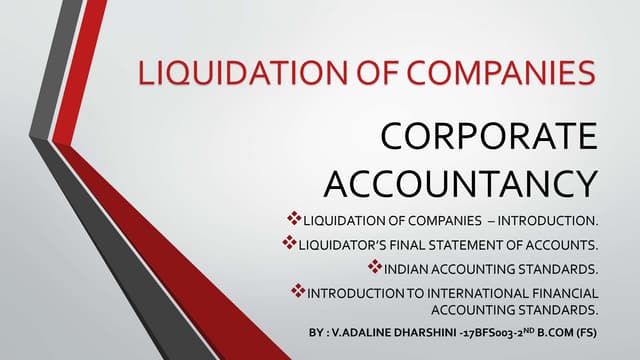What Does Company Liquidation Do?
What Does Company Liquidation Do?
Blog Article
Little Known Questions About Company Liquidation.
Table of ContentsGetting My Company Liquidation To WorkThe Company Liquidation StatementsMore About Company LiquidationExamine This Report on Company LiquidationThe Main Principles Of Company Liquidation
A liquidator is especially designated to look after the winding up of a business's affairs in order for it to be folded normally when the business is declaring bankruptcy. The liquidator is an unbiased 3rd party who oversees the sale of firm assets in order to settle any kind of arrearages.Their role consists of, but is not limited to: Unbiased Movie director: A liquidator is entrusted with functioning as a neutral third event to oversee the entire business liquidation procedure. Develop Statement of Affairs: Liquidators have to develop a comprehensive declaration of events record. This record is dispersed to creditors, describing the present economic standing of the organization at the time of its liquidation.
After the liquidation of a firm, its presence is removed from Firms Residence and it ceases to be a lawful entity. If directors browsed the process uncreative, there would certainly be no charges or personal obligation for strong debts expected. Currently, with a fresh start, supervisors can discover new service opportunities, though specialist appointment is suggested.
The Only Guide for Company Liquidation
If more than 90% of all firm shareholders agree, liquidation can take area on brief notice within 7 days, the minimum legal notice for lenders. Normally, the bigger the liquidation and the even more assets and funding the organization has, the longer the procedure will take.

We recognize that no 2 companies coincide, which is why we will certainly make the effort to learn more about your service so we can suggest the very best strategy for you. We only work in your benefits, so you can be totally confident in the solution we provide.
9 Simple Techniques For Company Liquidation
In the UK, there is an established process to folding or reorganizing a minimal business, whether it is solvent or insolvent. This process is recognized as liquidation and can only be managed by an accredited bankruptcy practitioner (IP) based on Recommended Site the Bankruptcy Act 1986. There are 4 main sorts of firm liquidation procedure: Creditors' Voluntary Liquidation (CVL); Obligatory liquidation; Administration; and Members' Volunteer Liquidation (MVL).

In these scenarios, it is essential that the firm stops trading; if business continues to trade, the directors can be held directly responsible and it could result in the bankruptcy expert reporting wrongful trading, referred to as misfeasance, which may lead to lawful action. The supervisors select an insolvency professional and as soon as this has actually been agreed and verified, there is a meeting with the investors.
The directors are no longer involved in what takes place, consisting of the sale of the company's properties. If the directors desire any of the properties, they can notify the IP.
The Ultimate Guide To Company Liquidation
The primary difference is that the firm's financial institutions applied to the court for an ending up order which requires the insolvent firm right into a liquidation process. Creditors take this action as a last hotel because they haven't gotten payment via other kinds of arrangement. The court designates an insolvency professional, additionally understood as a main receiver, to conduct the mandatory business liquidation process.
This kind of company liquidation is not volunteer and directors' conduct is reported to the UK's Assistant of State additional hints once the liquidation procedure has been finished. Any type of supervisor that stops working to comply with the IP or has actually been included in supervisor transgression, or a deceptive act, might result in major effects.
It is utilized as a method to secure the business from any type of lawsuit by its financial institutions. The supervisors of the company accept make normal repayments to resolve their debts over a time period. The appointed administrator handles the voluntary management process, and receives the settlements which they then distribute to lenders according to the concurred amounts.
The Single Strategy To Use For Company Liquidation
This provides the company with time to create a plan going onward to save the company and prevent liquidation. At this point, supervisors hand control of the company over to the designated manager. If a business is solvent yet the supervisors and investors go to website want to shut the business, a Members Volunteer Liquidation is the right choice.
The business liquidation procedure is managed by a liquidator designated by the supervisors and investors of the firm and they need to sign a statement that there are no financial institutions staying. The liquidation procedure for an MVL resembles that of a CVL because assets are understood but the profits are dispersed to the directors and the investors of the company after the liquidator's fees have been paid.
Report this page